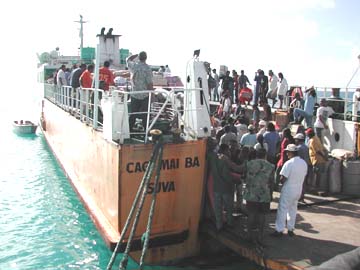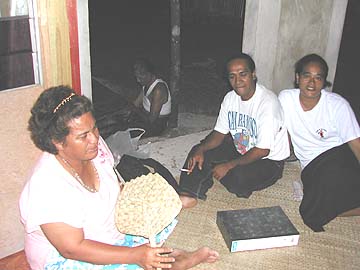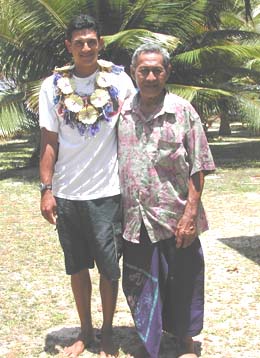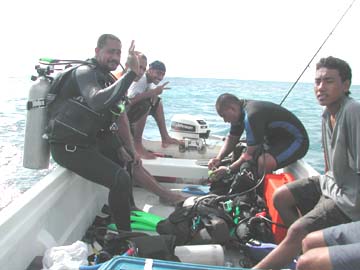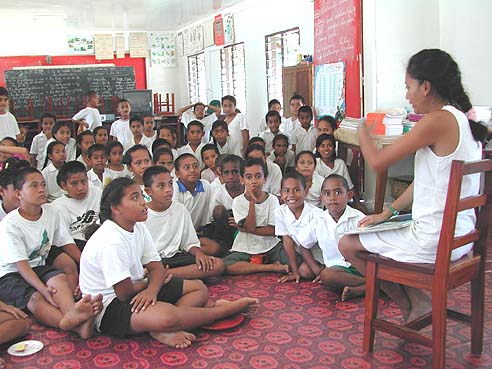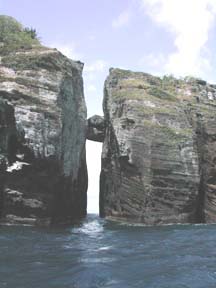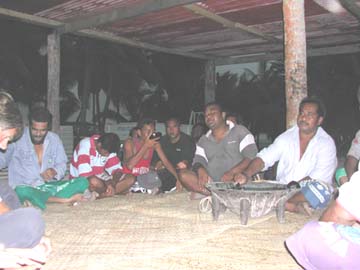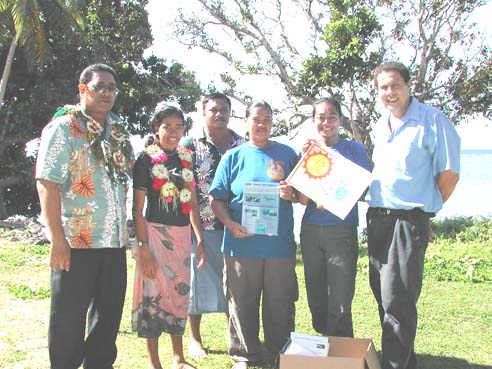|
|
||||||||||||||||||||
|
Rotuma Trip in August 2003 By six a.m. Monday, 2 August 2003, a few of us who traveled on the MV Cagi Mai Ba were up at on deck chatting happily and reminiscing about our early childhood days. This is my first trip to Rotuma this year and as always, on the last night of the sea voyage, there is an air of expectancy--that when we woke up, we would be seeing land. This trip was no different as we sat promising to watch the sun rise and listing our cravings, like having rourou or ‘iom niu and eating fish everyday! There was Safu, who is a medical doctor on leave, and had a sudden need to return home after years of being away; William, who teaches at the Rotuma High School and me. In the same group were three Malhaha boys who had left Rotuma for some time off from island-life and got stranded in Suva for two weeks because of of the MV Bulou ni Ceva's engine trouble, which is another story. Anyway, as the rain clouds lifted off the horizon to unveil Rotuma, a deep sense of peace and anticipation came over me. I never cease to be amazed by the impact of watching Rotuma with its lush green hills, the rows of coconut trees lining the coastline, and the pockets of white sand that appear as the swells turn down. The skies promised a wet day, but that didn’t dampen most of the passengers’ spirits, not even one of the guys contemplating a return to his usual schedule and a plantation knee-high with weeds as a result of being neglected. The conversation reminded me of my mission this trip, to do as much work as possible.
Since I had only a week to carry out the community workshop at the identified district, my plans involved school visits, identifying the new island coordinator, and meetings with government heads and the island's volunteer network. The first resource conservation workshop was held in Pepjei because of the immediate plight the community faces from coastline erosion and the deterioration of its seawall, threatening the village setting. In my opinion, and from ideas discussed previously in the last phase, the kama phenomenon is a contributing factor. Kama growth seems to have drastically changed the foreshore relief of Pepjei. There is no longer a gradual change from deep to shallow water, causing the constant physical force of strong oceanic waves to hit the sandy beach directly, with no relief or protection by the barrier reef. This exposes the beach rock and is destroying the man-made seawall along Pepjei’s foreshore. Another reason for choosing Pepjei was the cooperation and enthusiasm for LäjeRotuma last time, so we decided that it would be encouraging for all involved to start the mammoth task of community resource conservation (CRC) efforts there.
The workshop was carried out at the evenings, allowing all community members to be present at the village hall. The participatory and learning action tools were used to facilitate discussion of the villagers' concerns and their approach to natural resource management. We met from 6 to 9 p.m. for four evenings. The meetings were very interesting and productive, and I always looked forward to them; they concluded with the creation of a community management action plan. I must say I find the Pepjei people forthright and fun-loving. During day I visited the schools with Island Coordinator Ritia Atalifo and arranged for the coral reef survey work to be done in October. One memorable moment was when I realized that I was not homesick anymore for Noa'tau, the village where I grew up, because I had come to regard Pepjei equally as home. One thing that impressed me about Pepjei is the industrious nature of the people there, exemplified by the establishment of a coconut oil refinery, and yet there is a spirit of unity amongst them. It is especially encouraging to see all fit persons working in shifts throughout the week to scrape, heat, squeeze, and measure the oil extract. They were able to see the usefulness of this community project as there was a lack of cooking oil in the shops, creating a market for the villagers to sell their pure coconut oil to neighboring villages. It seems that everyone’s goal for this business venture is to secure an export market. I was amazed that the people, including the younger men, shared and discussed things so freely during the CRC workshop and the following grog sessions. I was touched by the humor, the singing around the grog bowl, the friendliness, and the heart of the people. The knowledge they have and so freely shared with me and the other PLA trainers is humbling. So when I left for bed each night and the others returned home, my head, despite its "grogged" state, buzzed with the lessons learnt that day. I am thankful for all those who contributed to and assisted in the CRC workshop, from the signboard helpers to the PLA trainers, and all the gang at Pepjei. Written by: Monifa's Journal LäjeRotuma Coral Reef Dive Team:
LäjeRotuma Socio-economic & CRC workshop team:
27th-29th September 2003
There was no option for leaving any of the stuff behind because then the survey team would be in jeopardy. All was well in the end; we finally got ourselves and the gear on the MV Cagi Mai Ba. Sunday was spent out at sea and for some of us it was time for catching up on sleep, with many anticipating the time ahead of us. On that last night on board whilst sitting on the container, chatting with some of the guys and enjoying the occasional salt spray, an older man from the group told me to expect good weather for our stay on the island as he pointed to the half moon with its crescent turned up, suspended in the star-studded sky. His words were: “the half upturned moon is a bowl in the sky capturing all that rain that threatens to fall at any time.” I thought it sounded a bit romantic but not for long, as the waves proved more viscious and the salt spray was becoming more of a wave threatening to engulf us, so everyone decided to enjoy the final night indoors. The trip was not a comforting one as the seas were a bit rough on some of us who preferred to be in horizontal positions during sea voyages. On many occasions I thought to myself that such recurring sea voyages are becoming tiring. Well, moods changed once we were nearing home. The gloomy skies shed a shadowed light on Rotuma and its undulating hills appeared somewhat a shaded green. This sight has always amazed me; it is a moment of reflection on all challenges that we encountered during the preparation of any such trip. I think it was also obvious that I wanted to share this with our two non-Rotuman dive volunteers, Diane Walker and Baravi Thaman. Oinafa seemed more welcoming than ever, with its white sandy beach and the aqua blue waters, today looking dampened by the cloudied skies. Offloading was as hectic as when we loaded back in Suva. It was good to meet family.
We reached our base camp late afternoon and a mamasa ceremony was accorded to our volunteers, Baravi and Diane, for their first time on Rotuma. For Fiu Manueli, the dive officer, it has been over 30 years since he was last here back home. For me, I couldn’t wait to greet the sea with a moonlight swim. It has been a long day for the team and an early night for all, as tomorrow would be day one of the science training of all dive volunteers. 30th–1st October 2003 2nd-4th October 2003:
At the end of the day I comfort myself by thinking that first days for such a feat always put a strain on everyone involved, and that mistakes are bound to happen. We are all new at this sort of thing. The Community Resource Conservation (CRC) workshop started today at Motusa in the evening and will continue for the next 3 evenings according to the village schedule. Motusa is our second CRC community and was chosen ahead of other communities, as LäjeRotuma intended to conduct a seagrass survey at Maka Bay. We thought it best to make the community aware of the importance of the seagrass habitat before any surveys were done in their bay. During the day, the socio-economic survey team conducted a survey at Fapufa. The second day didn’t prove so tiring because everyone got to the dive site on time. I think the visit to Rotuma High School (our changeover site for the teams) proved less hectic than otherwise anticipated. I also visited the Malhaha Primary School to present some information brochures provided by the Department of Environment, WWF, and the International Waters Programme. The day also proved eventful for Teri, who conducted a netball coaching clinic for students of the high school during her 45 minute surface interval. The Rotuma High School faculty hosted the team to morning tea, lunch, and since it coincided with World Teachers Day, there were tefui for everyone. It was also the day when I broke my survey diving record by using more than 100 bars of air for a 55 minute survey.
Bottom time for any survey usually takes about 35-40 minutes, but I was in a rather challenging site where the surge was pretty strong for a featherweight person such as me. Baravi must be commended for carrying the heavy duty stuff for me and even going down with me to hammer the stakes down to mark our permanent sites on the hard reef substrata. Saturday was all work and didn’t feel like it was a weekend until the afternoon when we hosted a BBQ for the island volunteer network. As for the boys, it was beach party time and induction time for Baravi with some of the best homebrew on the island. 5th October Sunday 6th-8th October Tuesday was planned for recreation day and the dive team did a dive at Hatana and snorkeled off Split Island. As for the dedicated socio-economic team, they stayed behind and conducted a socio-economic survey at Noa'tau and Pepjei. The CRC workshop continued at Motusa for the last evening where it discussed a community management plan. I feel must share my personal account of my adventure at Hatana. Legend has it that Raho was buried there and knowing the legend behind it, I felt like Alice in wonderland.
Stories and legends became real for me when I saw the red bodied crab found only on Hatana, and saw the two stone gods that sat proudly in their glory before their gifts. I could feel an air about it when I stood before the two stones, but then decided to sit down cause I felt I was standing in front of two persons…it was crazy but that was how I felt. Things that one cannot ignore on Hatana are the birds, the ‘ahi (crabs) and the rich sea life…but the memory of Hatana that I will remember most is the grave beside the two stone gods. It was that of the maiden, daughter of one of the Tigarea forefathers as I was told, who sacrificed his only daughter to be buried with Raho. Maybe that explains why the Tigareas are privileged with such a gift as Hatana. I cannot help but feel sad for the girl and what it would have been like during those times. Oh, and Baravi reminds me to mention the souvenirs Sid and I got from the tricky business of landing on Hatana. The boat ride to Hatana was great fun with the Losa boys cracking jokes as usual, so when we reached Hatana, I just jumped off and swam for the rocks. I reached there no worry but as I stood on the slippery rocks going to the "bird sancturay" the wake of a huge wave swept me off my feet and I found myself back out to the deeper end and risked being smacked onto the smooth coralline covered rocks. I was finally able to get onto my feet with the help of the boys but earned myself a medal as I had a gash on my right elbow from trying to get myself up or risk being swept back to the deep blue. This experience sort of heightened my expectations of Hatana, I guess.
The experience at Split Island was equally great. Some of the guys decided to check out the island whilst the less adventurous snorkeled for half an hour before having to leave for Rotuma, as the cloudy skies predicted a change in weather not in our favor. On the way back I decided to take a nap at the bow of John’s boat as it promised an even longer journey back to Rotuma. Suddenly, I was wakened rudely by the bounce of a wave that had the coil of anchor rope up at the bow landing rather nicely (still in its neat coils) around my neck. I guess I looked ridiculous with that silly look on my face not knowing what hit me, much to the guys’ enjoyment. That evening, the dive team was hosted to dinner by Losa village. We took the opportunity to have a session with them, talking about what LäjeRotuma was doing and in particular consulting them of the possibility of a Community Resource Conservation workshop there. Another interesting topic that we discussed were the turtles; this is a subject for further discussion during their CRC workshop, I thought to myself.
It is Wednesday, the day when three of our team members left for Suva on the weekly flight. Camp was a little sad but the work must go on as the expedition ends in only a few days time and we have a very tight dive plan. How long we will stay depends on the government delegation’s schedule for returning to Suva. It was also the day when the good weather turned too nasty for any safe diving and good surveying. 9th-13th October 2003
To those of you who read my account of the first ever
Rotuma Coral Reef Survey, I am trying to share some of my memories
with you all, but this is only my personal account. I am sure that
other members of the team could tell tales more vivid than mine. LäjeRotuma
invites all who would like to volunteer their time, knowledge, and
resources; I can assure you that the cause is for real. It is the
time to do something while we still can to protect the fragile ecosystem
of Rotuma. It is everyone’s business to be involved and to join
a global movement to participate in the preservation of planet Earth
for the sake of our very own survival. I see LäjeRotuma Initiative
as a response to that universal call to do something in our own little
Rotuman way, not just for the benefit of others but for us today and
the future of Rotuma. |




